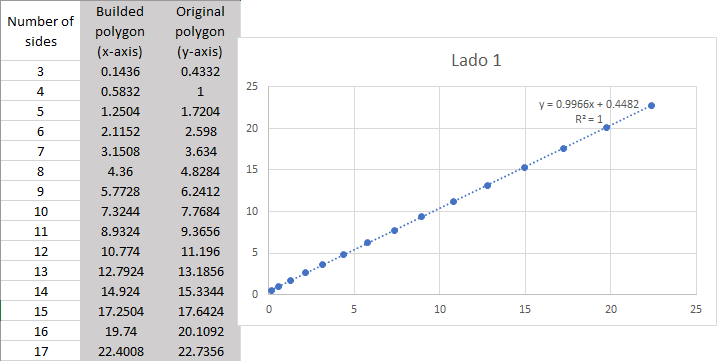Areas related with a linear equation
Some years ago, I posted two geometrical problems related with side-ratios in triangles and squares. This year, I was on my bed thinking when I remember this two problems and I try to generalize for regular polygons of n-sides. After some calculations in Geogebra, I found an interesting relation between the regular polygon (the original one) and the builded polygon which was a linear equation. The question from which the problem emerges is:
Let be a polygon of n sides (original) with vertex labeled from to . Between there is a point such , between there is a point such , between there is a point such and so on until complete the n vertex (builded).
Then, polygons' areas are plotted (axis- for the area of builded polygons and axis- for the area of the original polygons) to values from to
A linear equation is got it from the previous question.
For polygons of side one I got the areas in te table below which its graph

I did the same process for polygons of sides to and get the same linear equation. I'm intrigued about:
Why this data shows a linear equation?
How can I get a matemathical process to calculate the builded area?
Why the linear equations is so close from ?
Those are my main questions, I hope someone get interested in this problem and together we could work together on this.
Easy Math Editor
This discussion board is a place to discuss our Daily Challenges and the math and science related to those challenges. Explanations are more than just a solution — they should explain the steps and thinking strategies that you used to obtain the solution. Comments should further the discussion of math and science.
When posting on Brilliant:
*italics*or_italics_**bold**or__bold__paragraph 1
paragraph 2
[example link](https://brilliant.org)> This is a quote# I indented these lines # 4 spaces, and now they show # up as a code block. print "hello world"\(...\)or\[...\]to ensure proper formatting.2 \times 32^{34}a_{i-1}\frac{2}{3}\sqrt{2}\sum_{i=1}^3\sin \theta\boxed{123}Comments
Could you please upload a image of polygon ,say for n=4
Paola Ramirez posted this 1 year and 1 month ago.
Yeah, I understand and I think she is not probably active on brilliant right now
I agree with you. vasu paliwal, when did you start solving problems in brilliant? Are you new here?